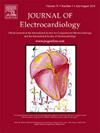The known high-risk p.R190Q KCNQ1-variant needs a second hit for QTc prolongation
IF 1.3
4区 医学
Q3 CARDIAC & CARDIOVASCULAR SYSTEMS
引用次数: 0
Abstract
The heterozygous missense p.R190Q KCNQ1 mutation represents one of the most frequent high-risk variants in long QT syndrome (LQTS). However, the presented case report and the data in literature led us to conclude that this heterozygous variant alone is associated with a low-penetrant clinical and electrocardiographical phenotype, while its co-inheritance with either the heterozygous p.E1053K SCN5A variant, some other LQTS-associated/modifying variant, or with some acquired QTc-inducing condition (like a specific leukaemia medication), may trigger QTc prolongation and thus a risk for arrhytmias.
已知的高风险p.R190Q kcnq1变体需要第二次打击来延长QTc
杂合错义p.R190Q KCNQ1突变是长QT综合征(LQTS)中最常见的高危变异之一。然而,目前的病例报告和文献数据使我们得出结论,该杂合变异体单独与低渗透的临床和心电图表型相关,而其与杂合p.E1053K SCN5A变异体、其他lqts相关/修饰变异体或某些获得性QTc诱导条件(如特定的白血病药物)的共同遗传可能引发QTc延长,从而增加心律失常的风险。
本文章由计算机程序翻译,如有差异,请以英文原文为准。
求助全文
约1分钟内获得全文
求助全文
来源期刊

Journal of electrocardiology
医学-心血管系统
CiteScore
2.70
自引率
7.70%
发文量
152
审稿时长
38 days
期刊介绍:
The Journal of Electrocardiology is devoted exclusively to clinical and experimental studies of the electrical activities of the heart. It seeks to contribute significantly to the accuracy of diagnosis and prognosis and the effective treatment, prevention, or delay of heart disease. Editorial contents include electrocardiography, vectorcardiography, arrhythmias, membrane action potential, cardiac pacing, monitoring defibrillation, instrumentation, drug effects, and computer applications.
 求助内容:
求助内容: 应助结果提醒方式:
应助结果提醒方式:


